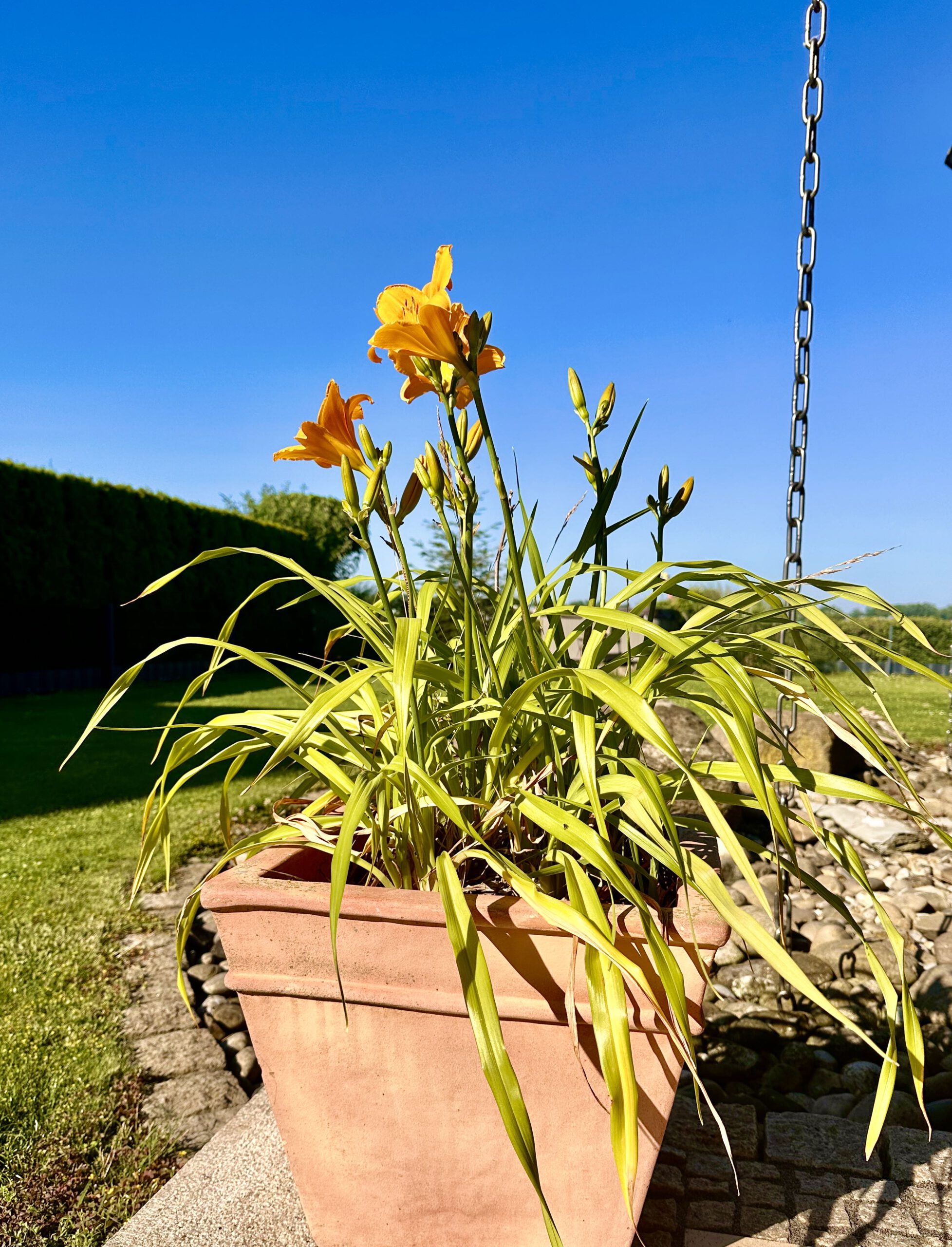Saphenion®: Therapie Krampfaderrezidiv mit Venenkleber
Saphenion®: Therapie Krampfaderrezidiv mit Venenkleber – Mt VenaSeal konnten bisher in 272 Fällen ektatische Krampfadern erfolgreich verschlossen werden. Neben dem standardisierten Protokoll ist ein dosierter asymmetrischer Druck und eine Abgabe eines Klebertropfens zweimalig in 1 cm Abstand erfolgversprechend.
Neben der standardisierten Abgabe des Klebers 3 – 5 cm von der Mündung der Stammkrampfader in die Beckenvene wird zweimalig im Abstand von 1-2 cm ein weiterer Tropfen des Klebers ( ca. 0,1 ml ) unmittelbar injiziert. Ein asymmetrischer sanfter Druck auf diesen Venenabschnitt unter sonografischer Sicht lässt uns eine gleichmäßige Benetzung des Klebers im erweiterten Gefäß erreichen.
Somit gelingt auch in diesen Fällen ein effektiver Verschluss der Krampfader. Von den behandelten ektatischen Venen wurde in 24 Fällen eine Rekanalisation gesehen. In 23 Fällen wurde eine erneute Venaseal® – Therapie erfolgreich durchgeführt. In einem Fall wurde nach erfolgloser Therapie zunächst die Radiofrequenztherapie durchgeführt, aber auch diese blieb erfolglos, so dass wir uns in diesem Fall zu einer lokalen Entfernung des Aneurysmas und einer Stammvenenunterbindung entschlossen haben.
Mit dem adaptierten technischen Vorgehen erreichten wir bisher eine Effektivität von über 94% Verschlussrate bei aneurysmatisch erweiterten Stammkrampfadern. Dabei ist eine individuelle Therapieanpassung an den jeweiligen anatomischen Befund nicht nur möglich, sie ist zwingend. Durch dieses modifizierte technisches Vorgehen lässt sich die Effektivität des Klebers weiter steigern.
Die bisher weitverbreitete Meinung, dass stark erweiterte Krampfadern > 1,2 cm Durchmesser nicht durch Venenkleber behandelt werden sollten, bedarf somit einer fachlichen Revision.
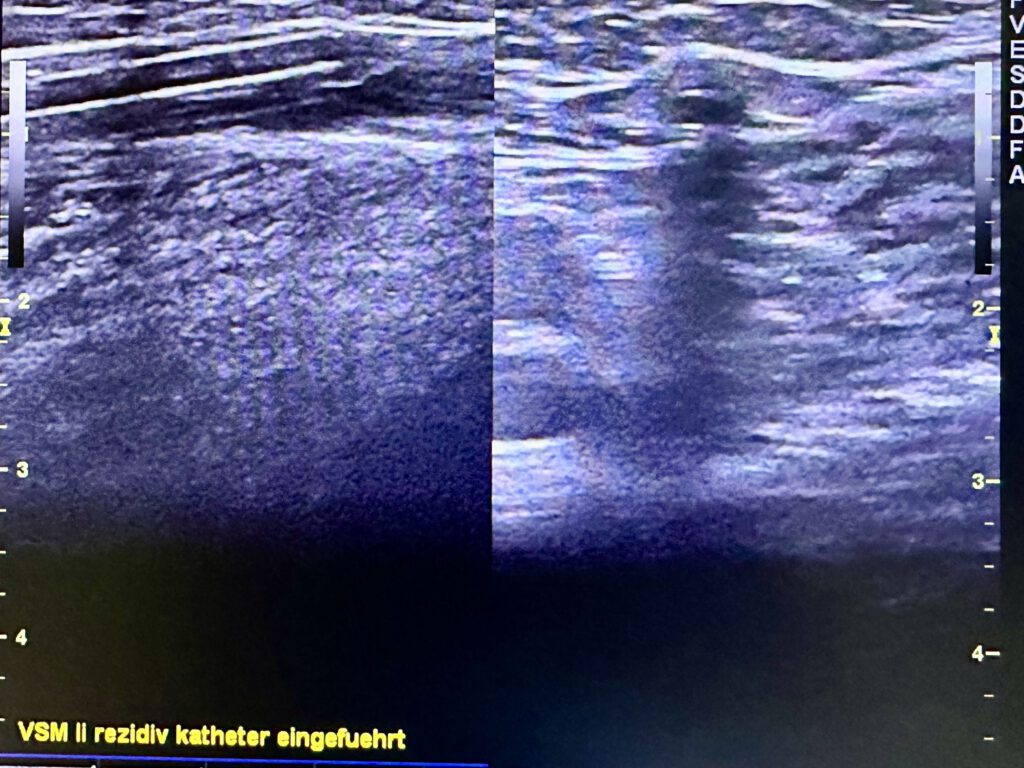
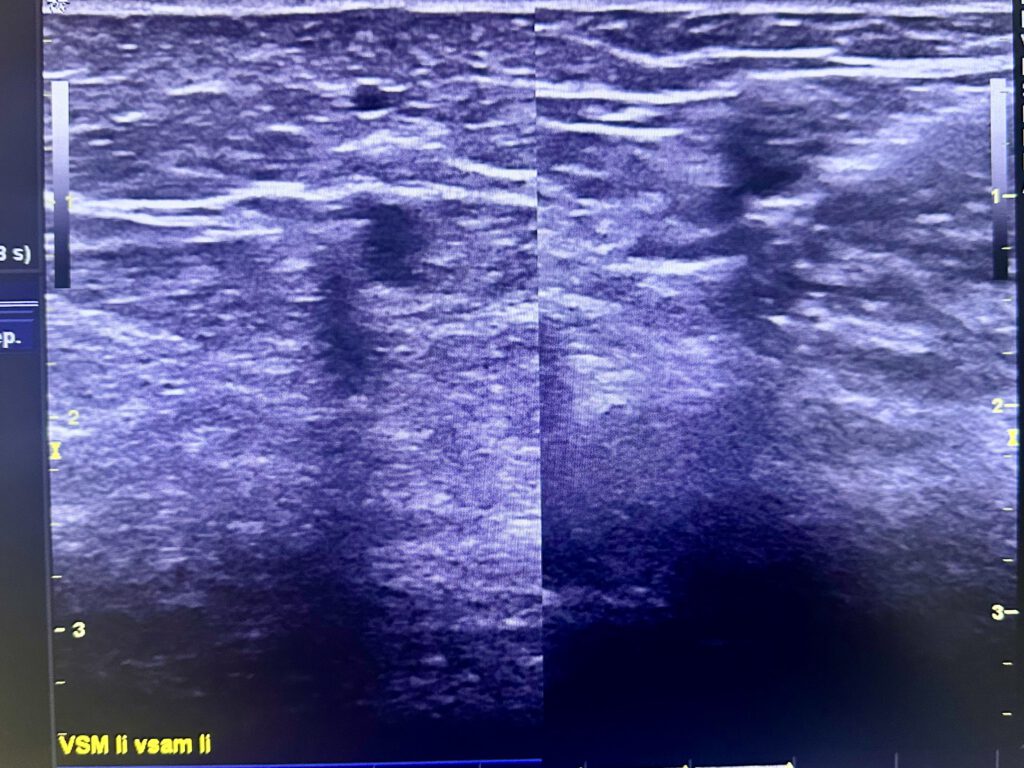
Saphenion®: Therapie Krampfaderrezidiv mit Venenkleber – rekanalisierte Vena saphena magna li. – auf dem linken Bild ist der Katheter nach Punktion am Unterschenkel in der Leiste sichtbar.
Saphenion®: Therapy of varicose vein recurrence with vein glue – recanalized left saphenous vein – the catheter is visible on the left image after a puncture on the lower leg in the groin.
Saphenion®: Treatment of varicose vein recurrence with vein glue
Saphenion®: Treatment of varicose vein recurrence with vein glue – VenaSeal has successfully closed ectatic varicose veins in 272 cases to date. In addition to the standardized protocol, a dosed asymmetrical pressure and a drop of adhesive applied twice at 1 cm intervals is promising.
In addition to the standardized delivery of the glue 3 – 5 cm from the orifice of the truncal varicose vein into the iliac vein, a further drop of glue (approx. 0.1 ml) is injected directly twice at intervals of 1-2 cm. Asymmetrical gentle pressure on this section of the vein under sonographic control allows us to achieve uniform wetting of the adhesive in the dilated vessel.
In this way, effective closure of the varicose vein is also achieved in these cases. Of the treated ectatic veins, recanalization was seen in 24 cases. In 23 cases, a new Venaseal therapy was successfully carried out. In one case, radiofrequency therapy was initially carried out after unsuccessful treatment, but this was also unsuccessful, so in this case, we decided to remove the aneurysm locally and ligate the trunk vein.
With the adapted technical procedure, we have so far achieved an effectiveness of over 94% closure rate for aneurysmatic dilated truncal varicose veins. Individual adaptation of the treatment to the respective anatomical findings is not only possible, it is mandatory. This modified technical procedure can further increase the effectiveness of the adhesive.
The previously widespread opinion that severely dilated varicose veins > 1.2 cm in diameter should not be treated with vein glue therefore requires a professional revision.
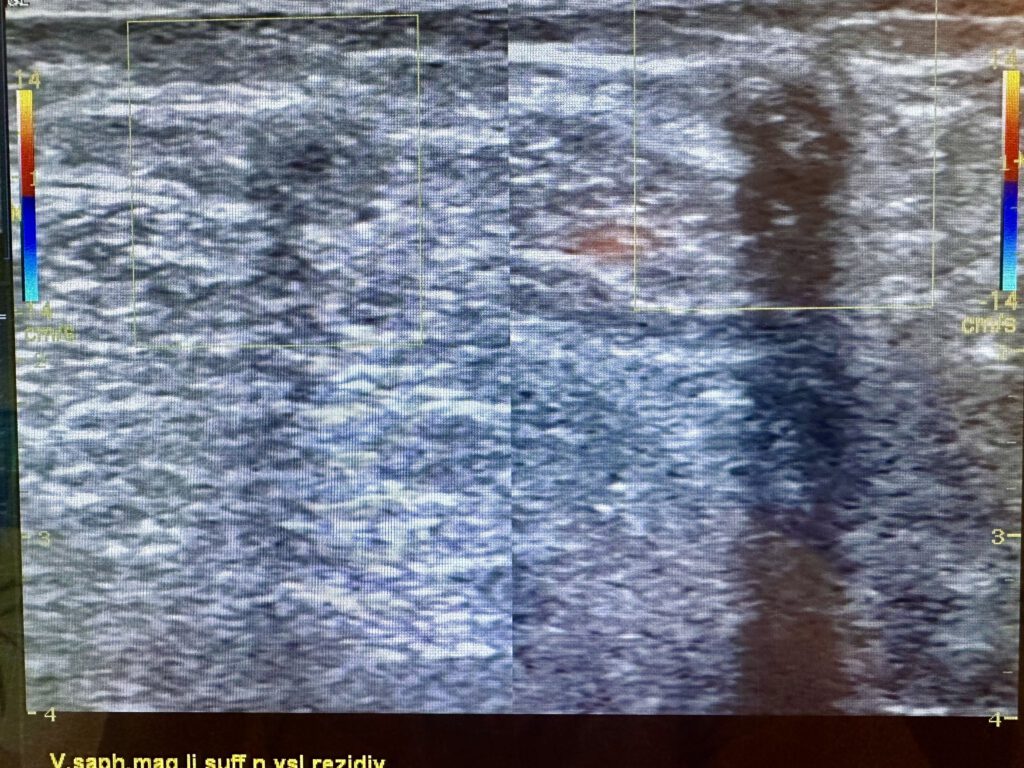
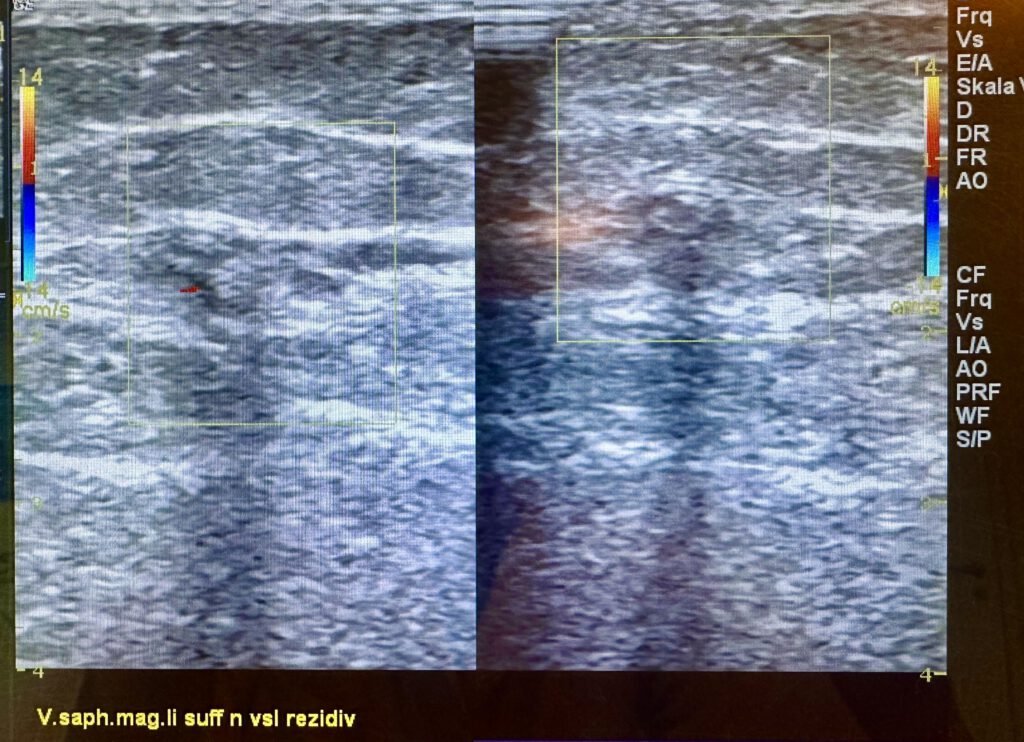
Saphenion®: Therapie Krampfaderrezidiv mit Venenkleber – die rekanalisierte Vena saphena magna li. ist vom Unterschenkel bis in die Leiste komplett verschlossen.
Saphenion®: Therapy of varicose vein recurrence with vein glue – the recanalized left saphenous vein is completely closed from the lower leg to the groin.
Saphenion®: Therapie Krampfaderrezidiv mit Venenkleber – eine Fallbeschreibung
Saphenion®: Therapie Krampfaderrezidiv mit Venenkleber – Unsere Fallbeschreibung ist aktuell vom 24. / 25. 6. 2024, unsere Patientin Frau Stephanie, 72 Jahre alt, kommt aus dem Berliner Grunewald. Wir hatten die Patientin vor 2 Jahren an der li. V. saphena magna mit dem Venaseal® – Kleber behandelt. Es ist unbedingt auch erwähnenswert, daß unser Patienten ausserordentlich viel Sport treibt, vom Rudern über Yoga bis zum Kraftsport.
Bei der Behandlung zeigte sich eine dtl. aneurysmatische Aufdehnung der Crosse und des 1. Magnasegmentes am li. Bein. Mit den oben beschriebenen zusätzlichen adaptierten Therapieerweiterungen erreichten wir mit dem Venenkleber zunächst einen kompletten Verschluss der segmental stark erweiterten Stammvene.
Ein Jahr später kam die Patientin, die zuvor in unserer ehemaligen Berliner Praxis behandelt worden war, zur Kontrolle des Befundes nach Rostock. Es fand sich nunmehr auch eine Stammvaricosis der re. Vena saphena magna 3 – 4°. Kurzfristig vereinbarten Frau Stephanie und unser Praxisteam einen weiteren Therapie – Termin für den VenaSeal® – Katheter. Die Befundkontrolle erschien dann 4 Woche später völlig unauffällig.
Im April diesen Jahres war kurzfristig ein weiterer Nachkontrolltermin vereinbart worden, da die Patientin unter leichtem Druck im linken Bein nach den intensiven sportlichen Übungen berichtete. In der funktionellen und duplexsonografischen Untersuchung zeigte sich dann auch eine partielle Rekanalisation der gesamten therapierten linken Vena saphena magna.
Wir prüften die katheteradaptierte Durchlässigkeit des Gefäßes mittels Ultraschall und empfahlen dann eine nochmalige Therapie mittels VenaSeal® – Venenkleber. Dieser Eingriff wurde dann gestern, am 24.6.2024, unter Sedierung mittels Dormicum durchgeführt. Mittels zweier Punktionen gelang tatsächlich eine vollständige Katheterisierumng der Stammkrampfader bis zur Leistenmündung (siehe Ultraschallbilder). Im Wissen um die etwas veränderte Gefäßanatomie wurde eine Kleberrhythmus von 2 cm je Tropfen gewählt.
Die heutige klinische, funktionelle und duplexsonografische Befundkontrolle ergab einen völlig unauffälligen post op befund, die Stammvene und eine zusätzliche akzessorische Vene am Oberschenkel konnten sehr gut und effizient verschlossen werden. Das zeigte sich sowohl im Ultraschall als auch in der Funktionsmessung beider Beinvenensysteme. Diese waren nahezu identisch im Normbereich. Das subjektive Befinden wurde ebenso als gut beschrieben (siehe Video).
Aus aktuellem Anlass wird hier noch einmal die Möglichkeit des Venenklebers gezeigt, vielfältig und nebenwirkungsarm bei der Therapie der Stammvaricosis eingesetzt werden zu können!
Saphenion®: Therapie Krampfaderrezidiv mit Venenkleber – Das Interview
Saphenion®: Therapy of varicose vein recurrence with vein glue – The Interview
Saphenion®: Treatment of varicose vein recurrence with vein glue – a case report
Saphenion®: Treatment of varicose vein recurrence with vein glue – Our case description is current as of June 24/25, 2024, our patient Mrs. Stephanie, 72 years old, comes from Grunewald in Berlin. We had treated the patient 2 years ago on the left saphenous vein with Venaseal® – glue. It is also worth mentioning that our patient does a lot of sports, from rowing to yoga and weight training.
The treatment revealed a possible aneurysmal dilatation of the crosse and the 1st segment of GSV on the left leg. With the additional adapted therapy extensions described above, we initially achieved complete closure of the segmentally severely dilated truncal vein with the vein glue.
One year later, the patient, who had previously been treated in our former Berlin practice, came to Rostock for a check-up of the findings. A varicosis of the right saphenous vein 3 – 4° was now also found. At short notice, Ms. Stephanie and our practice team arranged another treatment appointment for the VenaSeal® catheter. Four weeks later, the findings were completely unremarkable.
In April of this year, a further follow-up appointment was arranged at short notice as the patient reported slight pressure in her left leg after intensive sporting exercises. The functional and duplex sonographic examination then also revealed partial recanalization of the entire treated left great saphenous vein.
We checked the catheter-adapted permeability of the vessel using ultrasound and then recommended a second treatment using VenaSeal® vein glue. This procedure was then performed yesterday, 24.6.2024, under sedation with Dormicum. Using two punctures, a complete catheterization of the truncal varicose vein up to the inguinal orifice was achieved (see ultrasound images). In the knowledge of the somewhat altered vascular anatomy, an adhesive rhythm of 2 cm per drop was chosen.
Today’s clinical, functional, and duplex sonographic examination revealed completely unremarkable postoperative findings; the truncal vein and an additional accessory vein on the thigh could be closed very well and efficiently. This was evident both in the ultrasound and in the functional measurement of both leg vein systems. These were almost identical in the normal range. The subjective well-being was also described as good (see video).
Due to the current situation, the possibility of vein glue is shown here once again, used in a variety of ways and with low few side effects in the treatment of truncal varicosis.

Photos / Video: S. Nina, Utzius
Paper / Links:
Bontinis V, Bontinis A, Koutsoumpelis A, Chorti A, Rafailidis V, Giannopoulos A, Ktenidis K. A network meta-analysis on the efficacy and safety of thermal and nonthermal endovenous ablation treatments. J Vasc Surg Venous Lymphat Disord. 2023 Jul;11(4):854-865.e5. doi: 10.1016/j.jvsv.2023.03.011. Epub 2023 Apr 6. PMID: 37030442.
Chan YC, Cheung GC, Ting AC, Cheng SW. Modification of protocol with one extra drop of endovascular cyanoacrylate improved closure rates in incompetent great saphenous veins. Phlebology. 2022 Jul;37(6):425-431. doi: 10.1177/02683555221082358. Epub 2022 Mar 26. PMID: 35341399.
Joh JH, Joo SH. Complex Hypersensitivity and Irritation Reaction (CHAIR) Phenomenon after Cyanoacrylate Closure of Varicose Vein. Vasc Specialist Int. 2023 Sep 25;39:27. doi: 10.5758/vsi.230062. PMID: 37748929; PMCID: PMC10519939.
Morrison N, Gibson K, Vasquez M, Weiss R, Jones A. Five-year extension study of patients from a randomized clinical trial (VeClose) comparing cyanoacrylate closure versus radiofrequency ablation to treat incompetent great saphenous veins. J Vasc Surg Venous Lymphat Disord. 2020 Nov;8(6):978-989. doi: 10.1016/j.jvsv.2019.12.080. Epub 2020 Mar 20. PMID: 32205125.
Linn YL, Yap C, Soon S, Chan SL, Khoo V, Chong TT, Tang TY. Registry to investigate the efficacy and safety of the VenaBlock© VeIn SEaling system for VaRicose veins in Singapore – Six months of the RIVIERA trial results. Phlebology. 2021 Dec;36(10):816-826. doi: 10.1177/02683555211025181. Epub 2021 Jun 21. PMID: 34152882.
Park I. Ethical Considerations and Adverse Events in Cyanoacrylate Embolization for Non-Saphenous Veins: A Case Report. Vasc Specialist Int. 2024 Mar 4;40:6. doi: 10.5758/vsi.230102. PMID: 38433505; PMCID: PMC10910212.
Tang TY, Yap CJQ, Chan SL, Soon SXY, Yap HY, Lee SQW, Choke ETC, Chong TT. Early results of an Asian prospective multicenter VenaSeal real-world postmarket evaluation to investigate the efficacy and safety of cyanoacrylate endovenous ablation for varicose veins. J Vasc Surg Venous Lymphat Disord. 2021 Mar;9(2):335-345.e2. doi: 10.1016/j.jvsv.2020.03.020. Epub 2020 May 7. PMID: 32387378.
